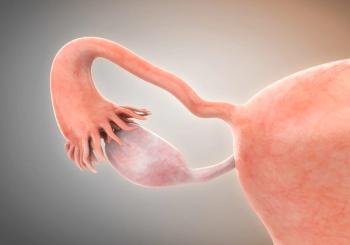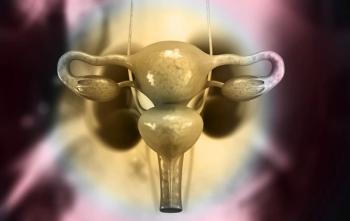
- ONCOLOGY Vol 16 No 8
- Volume 16
- Issue 8
Phase I Trial of Irinotecan and Epirubicin in Advanced Cancer
Both irinotecan (CPT-11, Camptosar) and epirubicin (Ellence) are significant chemotherapeutic agents that are used in the management of many different cancers. Each agent works through the inhibition of topoisomerases, and inhibition of topoisomerases I and II may possibly result in significant clinical synergy. This phase I clinical study represents an investigation of the first combination of irinotecan and epirubicin in patients with advanced cancer.
ABSTRACT: Both irinotecan (CPT-11, Camptosar) and epirubicin (Ellence) are significant chemotherapeutic agents that are used in the management of many different cancers. Each agent works through the inhibition of topoisomerases, and inhibition of topoisomerases I and II may possibly result in significant clinical synergy. This phase I clinical study represents an investigation of the first combination of irinotecan and epirubicin in patients with advanced cancer. Standard phase I eligibility was utilized, and recruitment proceeded in cohorts of three with escalating doses of irinotecan and epirubicin. The treatments were given on days 1 and 8 of a 28-day cycle. Our initial cohort of patients developed significant myelosuppression that required a modification in the initial dose-escalation scheme, and accrual to these lower doses is ongoing. Evidence of clinical activity has been observed. Accrual will continue until the maximum tolerated dose can be determined. Other schedules of the combination of irinotecan and epirubicin should be explored. [ONCOLOGY 16(Suppl 7):17-19, 2002]
Since the discovery of the parent compound 20(s)-camptothecin in1966, several derivatives have been prepared.[3] Two such agents, irinotecan(CPT-11, Camptosar) and topotecan (Hycamtin), have been approved for medical usein the United States.[4,5] Camptothecins are active agents in the treatment ofgastrointestinal malignancies, ovarian cancer, lung cancer, and myelodysplasticsyndrome, with activity also reported in other tumors such as brain and breastmalignancies.[6] Irinotecan is currently the leading camptothecin usedworldwide. The most significant impact of irinotecan to date has been in themanagement of metastatic colorectal cancer, but clinically relevant activity inmany other diseases has been documented as well.
Anthracyclines are antitumor antibiotics active against a widerange of hematologic and solid cancers. Anthracyclines inhibit topoisomerase IIand are involved in oxidation/reduction reactions through the generation of freeradicals.[7] Antiproliferative activity is thought to result from these andother mechanisms. Since its introduction into clinical practice in the 1960s,doxorubicin has been recognized as one of the most active antineoplastic agentsavailable, with a wide spectrum of antitumor efficacy. Epirubicin (Ellence)hydrochloride is a synthetic derivative of daunorubicin (DaunoXome), theprototype anthracycline. Epirubicin is the 4¢ epimer of doxorubicin; itsstructure differs from that of doxorubicin only in the reorientation of a singlehydroxyl group at the 4¢ position.[8] Epirubicin was identified throughscreening a series of doxorubicin derivatives that could potentially improvetherapeutic index as compared with the parent compound.
Combination chemotherapy is important in the treatment of manytumor types, as it can achieve additive or synergistic cytotoxicactivities.[9,10] The DNA topoisomerases I and II are targets of severalantineoplastic agents. Depletion of the target topoisomerase can be accompaniedwith reciprocal changes in the other topoisomerases. Targeting bothtopoisomerases I and II could therefore offer significant synergy. Inpreclinical models, inhibition of topoisomerases I and II has resulted insynergistic activity when such agents were administered sequentially in severaltumor types. While clinical data are limited, a phase I study with topotecan(topoisomerase I inhibitor) followed sequentially with doxorubicin(topoisomerase II inhibitor) showed that this combination can be given safelywith hematologic toxicity as the dose-limiting toxicity.
Both irinotecan and epirubicin play important roles in cancertherapies today. Each has a broad spectrum of action with the additionalpotential for clinical synergy. Except for bone marrow toxicity, the two agentshave few toxicities in common. The phase I study reported herein is exploringthe clinical potential of the combination of irinotecan (topoisomerase Iinhibitor) and epirubicin (topoisomerase II inhibitor) in patients with advancedcancer. Only very preliminary data are available so far for this ongoing trial.
Trial Design
Study objectives are to determine the dose-limiting toxicity andmaximum tolerated dose of the combination of irinotecan and epirubicin whenadministered in a day 1 and day 8, every-28-days cycle. Additional goals are todetermine the pharmacokinetics of each agent to assess potential druginteractions, and to document any observed antitumor responses in the hopes offocusing phase II efforts with this combination.
Extra care was taken due to the high probability ofmyelosuppression, as was seen with similar combinations. The starting irinotecandose was 100 mg/m² on days 1 and 8 given every 28 days. This dose representsless than 50% of the recommended phase II dose of 125 mg/m² weekly for 4 weeksfollowed by a 2-week rest. In the literature, the recommended epirubicin dose is135 mg/m² given every 3 weeks as a single agent or 60 mg/m² on days 1 and 8every 4 weeks when used in a combination regimen. The starting epirubicin dosein this phase I study was 40 mg/m² on days 1 and 8, which is 59% of thesingle-dose epirubicin given every 3 weeks and 66% of the epirubicin dose whengiven on days 1 and 8 every 4 weeks. Dose escalation is detailed in Table1.
Entry criteria included histologically documented incurablemalignancy, age of at least 18 years, anticipated survival of at least 8 weeks,and Eastern Cooperative Oncology Group (ECOG) performance status of 0 to 2.Patients had to have adequate end organ function, including normal hepatic andrenal function. Also required were a white blood cell count above 3,000/µL, anabsolute neutrophil count above 1,500/µL, and a platelet count above100,000/µL. Normal cardiac function, as measured by radionuclide ventriculogramscan (ejection fraction greater than 50%), was also required.
Patients must have recovered from the reversible side effects ofprevious therapy. Exclusion criteria included previous doxorubicin treatment ofmore than 240 mg/m², severe anorexia or vomiting, significant recent weightloss, pregnancy or lactation, serious intercurrent medical illnesses, history ofcongestive heart failure, and concurrent immunotherapy or radiotherapy. Allpatients provided written informed consent.
According to the original study plan, patients were to beenrolled at dose level 1 with starting doses of irinotecan at 100 mg/m² andepirubicin at 40 mg/m² (Table 1). One treatment cycle was 4 weeks, with studydrugs administered on days 1 and 8 with the subsequent 2 weeks off. Irinotecanwas to be given over 90 minutes and epirubicin was to be given over 5 minutesintravenously. Using a typical phase I dose-escalation scheme, three patientswere to be treated in each cohort. If no dose-limiting toxicities were observedin the first treatment cycle, an additional three patients would be started atthe next dose level. However, because significant myelosuppression was observedin patients at the first dose level, the protocol was modified as shown in Table2.
Dose-limiting toxicity is defined as a treatment-relatedtoxicity severe enough to preclude additional therapy for that patient, and istypically grade 3 or 4 toxicity. The maximum tolerated dose is defined as thehighest dose level that does not result in dose-limiting toxicities in two ormore of six patients treated at that level.
Blood samples are being obtained from all patients atpredetermined intervals on day 1 only. Samples will be analyzed to determineclearance and half-life of both irinotecan and epirubicin. Specifically, thisanalysis will help determine whether concurrent administration of the twocompounds results in any significant pharmacokinetic interactions.
All treatment is delivered on an outpatient basis. Patients areevaluated on each day of treatment by physical examination and laboratorystudies including hematologic and chemistry panels. Tumor assessment isconducted at baseline and again every 8 weeks (or two cycles). Repeat ejectionfraction is assessed after patients have received 450 to 500 mg/m² ofepirubicin. Patients who are tolerating the therapy reasonably well and gainingclinical benefit (ie, stable or improving disease status) may continue on thestudy.
Results
Four patients were accrued to the initial cohort. Theircharacteristics are listed in Table 3. Two patients had to be replaced due torapid disease progression and two developed a dose-limiting toxicity. Nosignificant acute toxicities were observed, namely, no significant diarrhea ornausea/vomiting. However, two of the four patients had myelosuppression asdose-limiting toxicity. Both patients were re-treated at reduced doses andcurrently remain on study. Toxicities are summarized in Table4. One patientwith metastatic gallbladder cancer had a minor response accompanied by a 50%decrease in carcinoembryonic antigen level. Another patient with metastaticpancreatic cancer had stable disease and symptomatic improvement.
Conclusions
The combination of topoisomerase I and II inhibitors previouslyhas been shown to result in significant myelosuppression, and we have observed asimilar effect in early results of this trial. Once a maximum tolerated dose isidentified and the pharmacokinetic data analyzed, selected phase II studies willbe initiated in patients with gastric cancer and cholangiocarcinoma/bile ductcancers. The day 1 and 8 schedule is convenient for patients and has resulted inacceptable acute side effects. Although it is possible that alternativeschedules (such as every 14 days or every 21 days) may allow for higher doseescalation, we suspect this will not be the case.
References:
1. Cummings J, Smyth JF: DNA topoisomerase I and II as targetsfor rational design of new anticancer drugs. Ann Oncol 4(7):533-543, 1993.
2. Malonne H, Atassi G: DNA topoisomerase targeting drugs:mechanism of action and perspectives. Anticancer Drugs 8(9):811-822, 1997.
3. Wall ME, Wani MC, Natschke SM, Nicholas AW: Plant antitumoragents. 22. Isolation of 11-hydroxycamptothecin from Camptotheca acuminata Decne:Total synthesis and biological activity. J Med Chem 29(8):1553-1555, 1986.
4. Horowitz RW, Wadler S, Wiernik PH: A review of the clinicalexperience with Irinotecan. Am J Ther 14(5/6):203-210, 1997.
5. Burris HA: Topotecan: Incorporating it into the treatment ofsolid tumors. Oncologist 3(1):1-3, 1998.
6. Rothenberg ML: Topoisomerase I inhibitors: Review and update.Ann Oncol 8(9):837-855, 1997.
7. Booser DJ, Hortobagyi GN: Anthracycline antibiotics in cancertherapy. Drugs 47(2):223-258, 1994.
8. Camaggi CM, Comparsi R, Strocchi E, et al: Epirubicin anddoxorubicin comparative metabolism and pharmacokinetics: A cross-over study.Cancer Chemother Pharmacol 21:221-228, 1988.
9. Jonsson E, Fridborg H, Nygren P, et al: Synergisticinteractions of combinations of topotecan with standard drugs in primarycultures of human tumor cells from patients. Eur J Clin Pharmcol 54(7):509-514,1998.
10. Eder JP, Chan V, Wong J, et al: Sequence effect ofirinotecan (CPT-11) and topoisomerase II inhibitors in vivo. Cancer ChemotherapyPharmacol 42(4):327-35, 1998.
Articles in this issue
about 23 years ago
Irinotecan and Other Agents in New Combinations and Other Tumor Typesabout 23 years ago
New Edition of Cancer Care’s Helping Hand Availableabout 23 years ago
Handbook of Gynecologic Oncologyabout 23 years ago
Clinton/Reid Bill Would Boost Cancer Tracking at CDCabout 23 years ago
House Restores Some Medicare Physician Pay Cutsabout 23 years ago
Medicare Proposes Calendar 2003 Pay RateNewsletter
Stay up to date on recent advances in the multidisciplinary approach to cancer.



















































































